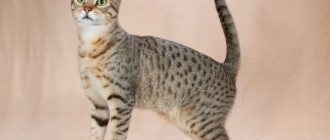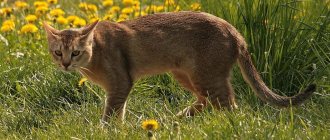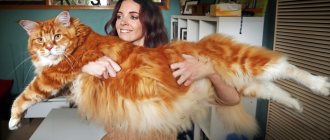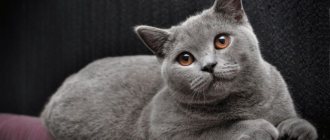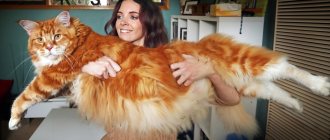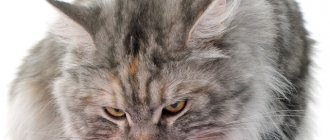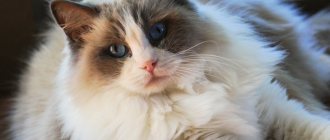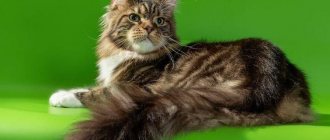Savannah
This animal amazes others with many of its characteristics, namely height, weight, etc. But the main surprise awaits those who decide to buy a kitten of this breed for themselves. The price is truly astronomical, although it is due to the fact that this breed has only 1 thousand individuals, and the first offspring were born only in the spring of 1986.
The basis of this breed was the domestic cat and the wild African serval. As a result, an animal was born, distinguished by its unique color, large ears, long legs, as well as fantastic jumping ability (up to 3 meters) and love for the water element. Savannah not only loves to swim, she is an excellent swimmer and is able to cover enormous distances across the surface of the water.
In addition, the Savannah has a developed intellect, she has an easy-going character and is devoted to her owner.
Curious cases
One of the criteria for giant cats is also their weight. And in this case, the winner was none other than SpongeBob, who was included in the Guinness Book of Records under the category of the most plump cat.
His weight was 15kg. Today, this cat had to be put on a serious diet. And according to a certain decision of the book’s founders, this section of the record was withdrawn for the safety of the feline representatives, so that breeders would not sacrifice their health to win.
Over a long period of time, similar nominations were awarded several times, and the most impressive result was that of the Austrian cat Khiimiya. He weighed about 21 kg and subsequently died from obesity.
Of course, having the biggest cat in the house is nice and partly becomes pride, but the main thing is, first of all, love for the animal and caring for it.
Maine Coon
This breed rightfully takes second place in the list of the largest cat breeds. Representatives of this breed have a weight of about 15 kilograms and a rather menacing appearance. At the same time, they find a “common language” with both adults and children, without offending pets either.
These animals have a characteristic color and a powerful tail, like raccoons. Thanks to these features, the name appeared, which translated means “Mensky raccoon”. Maine is the name of the state in the United States where the ancestors of Maine Coons were once kept on farms.
The breed is practically devoid of disadvantages, with the exception of its astronomical cost. Cats are easy to train and always demonstrate nobility, intelligence, calm disposition and grace.
10 ABNORMALLY BIG CATS IN THE WORLD
TOP 9
Let's look at the largest cat breeds known and bred today.
Savannah
Today the Savannah is the leader in the ranking of large breeds of domestic cats. It was bred by American breeders who crossed African servals (wild bush cat) and domestic cats (Egyptian Mau, Bengal, Ocicat).
Breeders set themselves the task of obtaining a cat that is adapted to living next to humans, is friendly and at the same time has the characteristics of its wild counterparts: exotic color, large size.
Since 2015, the Savannah has been considered the most expensive cat breed. The price depends on the amount of Serval blood in an individual. The most expensive are considered to be savannas, in which one of the parents is a wild serval, that is, having 50% of its genes.
Characteristic features of the breed are a long body, an elongated neck and limbs, and large cupped ears. The savanna reaches its maximum potential size by three years. These are cats with very high intelligence, and their devotion to their owner is not inferior to that of a dog.
Savannah should not be kept in a city apartment: she needs space, so only owners of country houses with plots should get a cat. This is an active animal that needs a lot of space and movement. Unlike other domestic cats, representatives of this breed are not afraid of water, they love to splash and play, so the presence of a pond or pool will be a pleasant surprise for your four-legged pet.
Chausie (housey)
A relatively new breed, bred by selecting the wild jungle cat and some domestic breeds. The weight of an adult can reach 10-12 kg, sometimes more.
They are friendly by nature, love to play, but prefer to communicate at a distance and it is better not to pick them up. The Hausi is devoted to her owner and loves to spend time with him. These cats are excellent hunters, strong and muscular.
Maine Coon
The Maine Coon occupies a leading position in the top ten largest domestic cats; before the breeding of the Savannah, it was the largest representative. He comes from North America; the ancestors of modern Maine Coons are considered to be Maine cats. There are many legends about the origin; according to one of them, the ancestors of such cats were raccoons.
Representatives of this breed reach a height of 0.4-0.45 meters, and weigh up to 8-9, sometimes 15 kg.
The body length of a Maine Coon, including its tail, can be more than a meter (the record holder is a cat whose length was 123 cm).
Due to their origin, Maine Coons are very hardy and well adapted to unfavorable climates. They have long and thick hair that grows even between their toes, and a large and fluffy tail. Maine farmers valued these cats for their excellent hunting qualities.
Domestic Maine Coons have a fairly friendly and peaceful character and get along well with children and other animals. Despite their size, cats of this breed are very neat, energetic and love to play. Maine Coons are very self-sufficient; they will not get in the way of their owners or ask them to be picked up.
Read more about Maine Coons on the Mister Cat portal.
Siberian
These beauties with long, thick hair and a fluffy tail are the largest representatives of Russian domestic cats. The weight of an adult can reach 9-10 kg.
Siberians are excellent hunters with highly developed instincts, so they prefer space. The cold does not frighten them; they tolerate the conditions of small apartments much worse, where it is difficult for them to be active.
Cats of this breed are willful, independent, but can become a wonderful friend.
Norwegian forest
These beautiful semi-long-haired beauties are large in size (up to 9-10 kg) and have a strong build. They are excellent hunters and fishermen, and are also the only cats who can descend from a height head down. Maybe that's why they love to explore the highest places in the apartment.
Norwegian cats have good manners, they are gentle and peaceful in nature, it is extremely difficult to provoke them into conflict or hooliganism. They get along well even with restless children and naughty dogs.
Representatives of this breed are very intelligent and quick-witted, love to play and are active until adulthood. In terms of their affection for people, they are very reminiscent of dogs; unlike other cats, Norwegians sincerely love a person, and not a house.
Due to the fact that such cats have very strongly developed instincts, including the instinct of self-preservation, they prefer to stay away from guests and strangers, but they show tenderness towards members of their family.
They do not like to be cuddled or placed on laps; they much prefer to sit next to a person, sing songs to him, and they love to be stroked and scratched. If a person tries to cuddle or kiss a “Norwegian”, he will quickly and clearly make it clear that he cannot stand such “tenderness”.
Ragdoll
Representatives of this breed fully justify their name, which can be translated into Russian as “rag doll.” These are phlegmatic people who allow you to do whatever you want with them: squeeze, kiss, comb, carry in your arms. Although this fluffy miracle cannot be carried around much: a Ragdoll cat can reach a weight of 10 kilograms or more.
These blue-eyed, soft-furred creatures are descendants of Persian, Angora and Burmese cats. Very friendly, calm and non-conflict purrs. They don’t like to hunt: it’s beneath their dignity, and they’re just too lazy. Perfect for apartment living.
Kurilian Bobtail
A distinctive feature of this breed is not only its large size (up to 7 kg), but also its short curled tail, reminiscent of a pompom. The description of the standard states that the tail should be from 3 to 8 cm in length and have several bends.
The homeland of these cats is the islands of the Kuril ridge, so they are not afraid of water, easily tolerate low temperatures, and know how and love to fish.
By nature, Kuril Bobtails are in many ways reminiscent of dogs: they are strongly attached to their owner (they choose only one, maximum two family members in this capacity), smart, inquisitive, and active. Such cats and dogs love games, for example, chasing a ball or a stick, many of them enjoy walking in a harness.
Pixie bob
These rather large cats can reach a weight of 8 kg, obtained artificially by Canadian breeders. The purpose of breeding was to obtain a breed suitable for domestic living and with the external characteristics of the American red lynx.
To do this, short-tailed forest cats living in North America were crossed with various breeds of domestic cats. The result was large pixie-bobs, which are also called short-tailed elves (after the first representative of the breed - Pixie, which means “fairy” or “elf”).
Despite the fact that outwardly cats of this breed look quite formidable, they are the sweetest creatures, they are extremely tactful, love tenderness, but do not require excessive attention.
Turkish van
This is one of the oldest breeds of domesticated cats. Vans are of natural origin, unlike many large cats; artificial selection has nothing to do with them. Their homeland is part of Turkey, the vicinity of Lake Van. The name of the breed comes from this toponym.
Adults reach a height of 0.4 m, a length from 0.9 to 1.2 m. Weight can be up to 9-10 kg.
The traditional color of the Van cat is considered to be a rich apricot color of the coat, and on the tail there are several rings of a more saturated shade.
A characteristic feature is the complete absence of hydrophobia, which is inherent in most domestic breeds. They love to play with streams of water, listen to their murmur, and can get completely into the water.
They have no undercoat, and the coat repels water and dries quickly. Thanks to this feature, they are excellent fishermen. They are very energetic, love to run and jump, involving people in their games. Their character is quite friendly, but they can demonstrate remarkable temper when they don’t like something.
If an animal is accustomed to a harness from childhood, then you can take it for walks: Vans love this very much, as they are very curious and active.
The energy of Vans should be taken into account by those who are planning to have a pet of this breed: they need to be played and exercised with them often, constantly updating their set of toys.
Chausie
It is considered not only one of the largest, but, at the same time, the rarest breed, the weight of which can reach at least 14 and a half kilograms.
The breed was born in 1990 and is a hybrid of an Abyssinian cat and a jungle cat. The jungle cat prefers to live in swamps, which is why it is also called the swamp lynx.
As a result of hard work, breeders managed to get a cat that has the power of a predator and the docile nature of a domestic cat. Chausie cats are quite strong cats, with an athletically complex body, a large (comparatively) head, large ears, and green or yellow eyes. Despite such external characteristics, the breed is devoted to its owner and feels great around children.
III place – representatives of the Chausie breed
Description of the breed
- In addition to the above two legitimate contenders for the title of “biggest cat,” one can imagine a representative of the jungle cats, the Chausie breed (also known as Chausie or Houseie).
- Weight: reaches 18 kg.
- Height: 40cm.
The main goal for creating this breed by crossing a jungle cat and an Abyssinian (see all photos of a jungle cat) was the idea of the breeders to get a variety of domestic cat to protect wild cats from being imprisoned in captivity.
See also what is the largest cat in the world, its weight and dimensions.
The goal was achieved and today the Shawzi gets along well with people and is quite loving towards them.
Ragamuffin
California is considered the birthplace of this breed, and it was born as a result of the efforts of Ann Baker, who decided to modify the Ragdoll. So she began to crossbreed the Ragdoll with other cat breeds, such as the Persian, the Yard Longhair, and the Himalayan.
As a result of these efforts, a breed was born that was called “cherub,” but at the last moment it was renamed and began to be called “ragamuffin,” which means “ragamuffin.”
Adults weigh at least 10 kilograms and acquire impressive sizes, although they mature only at 4 years of age. The breed does not have a beautiful, proportional physique, but it is distinguished by a variety of coat colors.
Turkish bath, 6-9 kg
Turkish Van cat has been bred in the Armenian Highlands since ancient times. Representatives of the breed are not afraid of water - on the contrary, they willingly dive into it, swimming in shallow bodies of water.
In the homeland of the breed - in Turkey, only white individuals with different colored eyes are listed - their appearance is truly impressive. When a Turkish bath grows up, it turns into a chatterbox! Moreover, the animal’s meowing is not annoying; it is very pleasant to listen to.
All Turkish baths love to play as soon as they are born, and their passion for chasing balls or chasing a bow does not disappear with time, so periodically the animal needs to buy new toys.
Kurilian Bobtail
The list of the largest cat breeds is replenished with another giant, since adult individuals can weigh at least 7 kilograms.
This breed of cats was once moved from the Kuril Islands to the mainland at the end of the last century.
The breed is distinguished by the original shape of its tail, which is quite short (only 8 cm maximum) and somewhat resembles a pom-pom. If a cat of this breed has a tail longer than 8 cm, then this is considered a fault of the individual, and if its length is only 12 cm, then the cat can be removed from the competition.
Kuril bobtails are not afraid of either moisture or frost, although they do not like to swim, but at the same time they are excellent at hunting fish.
The behavior of this breed of cat is somewhat reminiscent of the behavior of dogs, since they are very curious, are highly active and never refuse long walks and fun games, involving various toys, where they carry them in their owner’s teeth, like dogs.
Diseases that affect large domestic cats
The health of domestic cats, including large cats, depends on genetics, as well as how they are cared for and what they are fed. If the set of hereditary diseases depends on the breed, then the consequences of improper nutrition and maintenance are the same for all cats. They lead to pathologies such as:
- urolithiasis, although it is believed that all cats are predisposed to it. A healthy diet allows you to minimize the manifestations of the disease and the frequency of its exacerbations;
- food allergies, the cause of which in most cases is again considered to be improper feeding of the pet;
- skin problems: they can be the result of an unbalanced diet, poor care of the animal, as well as the presence of parasites in the fur;
- dysfunction of the digestive organs. In rare cases, they are caused by congenital diseases; more often they are caused by the consumption of stale, low-quality food, as well as foods prohibited for animals (for example, sweets, spicy and salty foods). In addition, the health of the digestive tract and the body as a whole is undermined by intestinal worms and protozoa. They reduce immunity and poison the internal organs of the animal with their waste products.
Diseases depending on breed
Each variety of domestic cat has a predisposition to certain diseases.
Table. Breed diseases of big cats
| Breed name | Photo | Possible health problems |
| Asherah | The breed has no genetically determined pathologies, which is explained by the good health of its ancestor, the Serval. Possible inflammation of the urinary system | |
| Maine Coon | Joint diseases (arthritis, arthrosis, osteoarthritis, hip dysplasia), skin pathologies (abscesses, phlegmon, ostiofolliculitis, eczema), disorders of the urinary system (nephritis, nephrosis, pyelitis, urethritis, cystitis) | |
| Ragdoll | Hip dysplasia, feline hypertrophic cardiomyopathy | |
| Chausie | Digestive disorders, obesity | |
| Siberian | Food allergies, inflammatory eye pathologies (conjunctivitis and others), obesity |
Norwegian Forest Cat
Due to the fact that the forest cat has long, fluffy fur, it seems that this animal is quite large. In fact, adults generally weigh no more than 9 kilograms.
There is a legend that this breed of cats was brought to Scandinavia by the Vikings in the holds of their ships. What these cats did on ships was to catch rodents, saving sailors from hunger and the bubonic plague, which was spread by rats.
In northern latitudes, cats became slightly domesticated, beginning to live next to humans. In 1934, the stage of breeding work with the Norwegian Forest Cat began, for which purebred representatives of this breed were sought throughout the world, as well as throughout the country. In 1976, the breed was officially recognized throughout the world.
The Norwegian cat is distinguished by its stable psyche; in addition, it is brave and strong, with the skills of a real hunter. These cats are not afraid to be with dogs that have the same easy-going nature, or near children. The Norwegian Forest Cat is considered to be one of the smartest.
In the wild and at home
There are people who like to keep a truly dangerous wild animal at home. It is believed that representatives of the cat family are best suited for these purposes. Considering that attempts to cross a wild cat with a domestic cat do not always lead to satisfactory results, the most desperate cat admirers decide to purchase a wild individual.
This decision can hardly be called reasonable, because living in direct contact with a predator can lead to unpredictable consequences. Having chosen such a pet, you need to carefully consider the conditions of detention and safety rules for it and, of course, for all household members.
So, wild cats that can theoretically be kept at home:
- Jaguarundi is an unusual cat with a face that resembles a weasel. The animal is native to South and Central America, whose closest relative is the puma. Despite such a serious relationship, the jaguarundi gets along well with humans. Cats are diurnal, quickly get used to their owner, and are easily tamed. The average weight of a male is 8 – 10 kg.
Jaguarundi
- Geoffroy is a relatively small cat native to South America. In appearance and habits it resembles a leopard, but is much smaller in size. The weight of an adult animal is about 5 kg; large cats can weigh 8 kg. Geoffreys are easy to train, especially if training begins at an early age. Cats are very affectionate, playful, and easy to make contact with. They can live both in a house or apartment, and in a cage on the street.
Geoffroy
- The caracal is another wild cat that lives near humans. Caracals can be trained, but it will take a lot of time and a lot of effort is required to get noticeable results. Keeping such a pet is expensive, and the animal is not suitable for living in a home. He requires a spacious outdoor enclosure. An adult male reaches a weight of 20 kg.
Caracal
- The Asian leopard cat is one of the most popular wild animals to keep as pets. Outwardly similar to a leopard, only smaller in size. The weight of an adult cat is 10 - 15 kg, with a body length of 43 - 45 cm. She gets used to living in a house quite easily if she is provided with suitable conditions. But keeping it in an outdoor enclosure is optimal.
Asian leopard cat
- Serval - ranks first in popularity among wild cats kept at home. The animal has a friendly disposition, they are capable of strong attachment to a person and remain devoted to him for many years. In terms of habits, the serval is in many ways similar to a dog. Very smart, easy to train. Can become an excellent protector for the owner. With proper upbringing, he grows up obedient, affectionate, and faithful. The weight of an adult male ranges from 9 to 18 kg.
Serval
The liger is considered the largest wild cat in the world. This animal is a hybrid resulting from the crossing of a lion and a tigress. Ligers are not found in the wild because lions and tigers have different habitat regions. The average weight of a male is 340 kg, height at the withers is 1.6 - 1.7 m. The Hercules liger is officially recognized as the largest representative of the breed. His weight is more than 420 kg, with a height of 1.86 m.
Siberian cat
According to some experts, the Norwegian cat and the Siberian cat have common ancestors. Despite this, the Siberian cat is distinguished by both intelligence and intelligence. Moreover, its weight can reach 12 kilograms.
These cats grew and developed in the conditions of the Far Eastern taiga, so they are absolutely fearless animals that are not afraid of their natural enemies.
The Siberian cat is not only smart, but also beautiful, and also not spoiled by selective artificial selection. She is an excellent example of a real hunter, as she is able to hunt even hares.
The Siberian cat has a calm and balanced disposition, which helps her find a “common language” with both adults and children. At the same time, she will easily show who is “the boss”, regardless of who is in front of her, a cat or a dog.
Leaders in the nomination “Largest cat breed”
Today, two fierce rivals vying for the title of “largest domestic cat breed” are: the Savannah and the Maine Coon.
It is no secret that the third competitor intended to be a representative of the Asher family. But, as it turned out, this breed was a fictitious creation of a felinologist and, as such, does not exist, but was simply given out by Savannah under the guise of an allegedly new unique Asher individual.
After exposure, this participant was disqualified from the competition, but it is worth knowing about some nuances regarding this case. Indeed, to this day no court decision has been made regarding this breed.
A thorough genetic examination is being carried out to reveal the truth about the creation of the Ashera. The owner of this newest species, Brady, assures that these two cats are completely different breeds.
He explains that the only similarity between these breeds is the serval gene, and the Asher also contains the genes of an Asian leopard cat and a predatory cat (see photo of an Asian leopard cat).
British Shorthair
Thanks to its powerful body and short hair, it seems that this is a huge, strong cat, although in fact males weigh no more than 9 kilograms, and females - 6 kilograms.
The breed has an independent character and does not like pleasantries. She is able to endure prolonged loneliness, although she loves her owner very much and misses him if he is not at home. Because of its unobtrusiveness, it received a second name - “cat for a businessman.” He is wary of strangers and does not let them get closer than a couple of meters to him. If he wants, he can easily catch a rodent.
They accept affection only when they want it themselves, while demonstrating a sense of self-worth.
IV place - charming ragdoll cats
Description of the breed
- Although the Ragdoll cat breed differs in size from ordinary cats, it is difficult to call it gigantic. Considering that the big ones in this breed are mostly males, and not all of them.
- Weight: 9 kg.
- Length: 1 meter (record).
- These cats, especially their breed, are also called rag dolls. And all thanks to their genetically built-in passionless ardor, cuteness and non-aggressive behavior.
Pixie bob
This cat breed is considered a national treasure of the United States and its export is prohibited by law.
The breed was bred artificially. The breeders' task was to obtain a forest lynx that was not at all large in size. All that remains of the lynx are the tassels on the ears and unique colors, as well as a short tail. Adults weigh from 5 to 8 kilograms.
Despite the presence of lynx genes, these cats are distinguished by their calmness and love for their owner.
